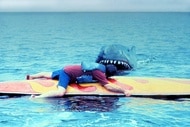Create a free profile to get unlimited access to exclusive videos, sweepstakes, and more!
Are Shark Attacks on the Rise? Here's What the Data Says
Is it safe to go back in the water?
Steven Spielberg’s 1975 shark-themed horror, Jaws (now streaming on Peacock and SYFY), took viewers to the fictional seaside town of Amity Island. Chief Brody (Roy Scheider) wants to close the beach following a deadly shark attack, but it’s tourist season, the town’s lifeblood, and he’s overruled. What follows is an accelerating sequence of attacks and a fight to the death on the open water.
A cursory look at the real-world headlines might have you in a panic, much like the fictional Chief Brody, and that’s understandable. It seems like every summer the news feeds overflow with one shark attack story after another, but that’s more a function of the 24-hour news cycle and the attention-grabbing nature of sharks, than any actual uptick in aquatic aggression.
For More on Sharks:
The 10 Weirdest (Coolest) Sharks of All Time
Great White Sharks More Common and More Chill Than We Thought
Drone Footage Snaps Up the First Known Baby Photos of a Great White Shark (Probably)
Shark Attacks Aren’t on the Rise, We’re Just Spending More Time in the Water
The Florida Museum of Natural History has been maintaining the International Shark Attack File (ISAF), since 1958. It investigates all ongoing reported attacks as well as historical attacks going back to the 1500s. There are some gaps in the data, as a result of unreported attacks and a couple decades of lackluster record keeping, but it’s the most comprehensive record of global shark attacks in existence.
The number of recorded attacks by decade does show an upward trend, so it’s true that the total number of shark attacks has gone up over time. Between 1900 and 1909, there were only 39 attacks reported globally. Two decades later, the number had more than doubled. By the 1960s, the number of attacks had risen to 227, and in the most recently completed decade, 2010 - 2019, there were 803 reported shark attacks.
The data does show an apparent drop from 1970 to 1989, but the ISAF notes that is an artifact of inactivity on their part, not an actual decline in human-shark interactions. For the most part, the number of shark attacks goes up in line with beach attendance. Every summer people flock to the beaches and every summer there are more people flocking than the year before. That’s the explanation for the apparent increase in shark attacks. All things being equal, 2024 is trending toward a “very typical, average year, no different than any other year,” according to Gavin Naylor, head of the ISAF (via USA Today).
When there are more people in the water, there are more opportunities for interactions, and there are more total attacks, but the odds that any one person will be attacked have remained pretty much the same. Sharks are just doing what they’ve always done, we’re the ones spending more time paddleboarding through their buffet line. Sharks aren’t out to get you, but they are wild animals, and the only truly safe sharks are cinematic.
Catch Jaws, streaming now on SYFY and Peacock, alongside Jaws 2, Jaws 3, and Jaws: The Revenge.



























